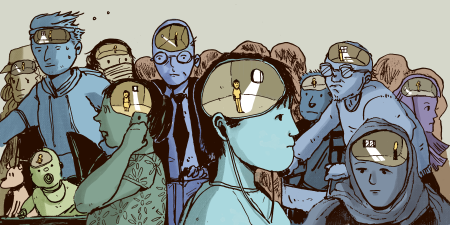Abstract
This article draws on 4 case studies from our group’s research on older adults living alone in the United States and suggests how artificial intelligence (AI) applications can be used to foster meaningful social connections. This article also warns against ways in which AI applications can reduce physical connections and suggests how AI technology should be implemented to avoid this drawback.
Artificial Intelligence and Connection
In health care, artificial intelligence (AI) can be used to achieve specific goals (eg, detecting falls) yet allow patients some autonomy by analyzing their environments (eg, databases of videos or text) and taking specific actions.1 Here, we aim to contribute to the conversation on the most effective pathways for AI to cultivate social connections with the goal of reducing social isolation and loneliness—2 conditions detrimental to our health.2,3 Isolation is more quantitative, with a paucity of meaningful social contact measured in terms of network size and community involvement.4,5,6 Loneliness is more subjective; its traditional definition is “a discrepancy between the actual and desired interaction with others.”6 We assume that these “others” are physical and human beings. Our assumption is based on evidence that our well-being is promoted by social connections with other human beings.7,8
Although living alone does not automatically imply that someone is either socially isolated or lonely,9 living alone can hamper efforts to maintain a rich social life, especially in old age; in developed countries, over half of women 80 years of age and older live alone.10,11 Barriers to connecting with others in old age range from death of partners and friends to having less stamina to organize outings while managing the household alone.12 As a result, older adults are at high risk of dying by suicide.13 In the United States, older adults have the highest suicide rate, with older White men having a suicide rate 4 times the national rate14 and older patients with a recent diagnosis of dementia also being at increased risk of dying by suicide.15,16,17
We focus on older adults because AI technology is often developed to support this population by compensating for their declining physical and cognitive abilities, as well as for their usually narrow social circles. Older adults are particularly vulnerable to loneliness and social isolation due to the death or institutionalization of partners and friends, as well as the geographical mobility of their adult children, if any, and the increasing trend of childlessness among younger women that will likely result in higher rates of childlessness as they age.18 Both loneliness and social isolation are associated with increased mortality in older adults.2,3 By contrast, physical connections (eg, seeing others in person, receiving and giving pats on the back and hugs) are extremely beneficial to older adults’ well-being and sense of belonging.19,20 Furthermore, while older adults in senior housing might experience social isolation,21 researchers have shown that older adults benefit from connections with people of different generations.21,22,23 If developed strategically, AI has immense potential for fostering social connections in old age, thereby decreasing social isolation and loneliness, especially among older adults living alone.
Harm or Help?
To contribute to the conversation on the most effective ways to use AI to foster social connections, we propose a distinction between AI aimed at promoting efficiencies and AI aimed at cultivating meaningful human connections. This distinction can be useful to clinicians when weighing whether to endorse the use of specific AI applications for their older patients.
“Efficiencies” and their disadvantages. An example of AI used to promote efficiencies in relieving social isolation and loneliness is electronic companions. For example, in 2022, New York public officers gave companion robots called ElliQ to 800 older residents “to help combat loneliness.”24 These small silver-and-white robots called ElliQ, like Siri or Alexa, interact with users via a touchscreen tablet.25 Skills of ElliQ include playing music, reciting poems, showing pictures, as well as giving reminders and greetings.26 A year earlier, in San Francisco, California, Ms Juanita Erickson, a 93-year-old woman living alone in a continuum of care residence, had received ElliQ to keep her company.27 Following suit, large hospital chains provided older patients with robots—“essentially, a video camera mounted on a metal pole”—whose “disembodied voices” often confused them, in order to cut nurses aides’ hours.28 Finally, the ease with which we can all download and chat with our avatar using AI applications, especially those designed to provide emotional support,29 might tempt clinicians to recommend them to older patients. We caution clinicians to beware of such AI-implemented shortcuts to foster meaningful social connections. We heed the warning of Sherry Turkle, the author of Alone Together: Why We Expect More From Technology and Less From Each Other.30 Turkle argues that interactions with electronic devices “cheapen the notion of companionship to a baseline of ‘interacting with something.’ We reduce relationships and come to see this reduction as normal.”30 AI can also reduce physical connections, which likely increases social isolation and loneliness.
If developed strategically, AI has immense potential for fostering social connections in old age.
Advantages. On the positive side, AI can be used to help foster meaningful and physical human connections. For example, rather than solely chatting with her companion robot, Ms Erickson, the older woman living alone in San Francisco, asked ElliQ to tell her funny jokes with which she could entertain her friends in the community room downstairs.27 We can also take lessons from AI designed to foster social connections for persons with disabilities,31 as disabilities studies often pave the way for aging studies.32 For example, the phone application AVA efficiently transcribes multiple voices so that persons with hearing impairments can engage in conversations. Similarly, the application Voiceitt helps people understand the words of persons with speech impediments because of brain injuries. Finally, the application Soundscape describes the surrounding environment to help blind people navigate trajectories outside their homes. Taken together, these examples point to the immense potential of AI to act as a social glue, fostering and facilitating meaningful and physical connections among older adults at risk of being socially isolated or lonely.
Cases
Efforts to address social isolation and loneliness should ensure that any interventions and applications are being offered to consenting older adults who want to have a richer social life. Some older adults enjoy solitude and do not need extensive and frequent interactions with others to feel deeply fulfilled. Solitude allows for contemplation, prayer, and creative pursuits, such as drawing and writing poetry.33,34 It is also important to consider preferences for different types of interactions. For example, an isolated man with cognitive impairment, who was living alone and described himself as a “recluse,” explained that his ideal of enjoyable social interactions was sitting in crowded venues and being a wallflower while observing others’ interactions. To provide some foundation and spark the conversation on possible applications of AI to foster meaningful social connections among older adults, we reflect on 4 cases from our group’s research on isolated older adults35 and older adults living alone with cognitive impairment.36,37
Case 1. Mr J, a 73-year-old legally blind man, lives alone in a building for seniors in a high-crime neighborhood. As a gregarious man, Mr J longed to play chess—to the point that, when he heard footsteps approaching his door, with mixed success he invited strangers to play chess with him, even though he was well aware of the risks of his behavior. He also longed to swim in a nearby swimming pool, so the first author drove him to the swimming pool and swam with him to better understand the barriers to realizing this longing. How could AI be leveraged to foster Mr J’s social connections?
We propose a few suggestions. First, with its ability to process large amounts of data, AI could be used to identify older residents at risk of social isolation and loneliness using parameters such as living alone, loss of spouse, and health conditions (eg, being legally blind, having cognitive impairment, having a history of depression). Second, AI could be used to identify possible companions for older adults who express interest in enriching their social life, such as Mr J, based on the type of activities and interactions they would enjoy. For example, we can imagine that Mr J would indicate playing chess and swimming as activities he would enjoy doing with others and the AI tool using this information to match Mr J with other persons interested in these activities. Furthermore, AI could be used to facilitate Mr J’s obtaining the public services needed to play chess or swim, such as taxi vouchers and an assistant to accompany him to venues. Perhaps new applications, such as ChatGPT, could be harnessed to connect isolated and gregarious older adults with public service officers.
Case 2. Ms W, a 72-year-old woman with cognitive impairment, lives alone in a minuscule hotel room. A monolingual Chinese speaker with a history of depression and suicidal ideations, Ms W has limited connection to her adult son. She is not as gregarious as Mr J, so she has limited meaningful connections. She particularly enjoys being helped by her public home care aide and walking in her neighborhood. In this case, AI applications, such as the Day Translations App, could be used to ease Ms W’s interactions with those who do not speak her first language.38 In addition, once someone (eg, a case manager) takes time to support Ms W in expressing the types of social interactions she might enjoy, the AI tool could identify others with whom she could connect.
Case 3. Ms T, an 82-year-old woman who lives alone, is concerned about her recent diagnosis of Alzheimer’s disease, which research indicates is a risk for suicide attempts.39,40 Ms T feels extremely isolated and lonely because her driver’s license was revoked, and she struggles to understand how to use buses. She longs to go to a shopping mall where she can see people. She would also like to get to know her neighbors, but she does not feel comfortable doing so. In her case, AI could be used to identify older adults like her who long for companionship, identify neighbors who enjoy walking and gardening (Ms T’s favorite activities), and provide transportation support. Considering her cognitive impairment, the design of AI applications would need to be extremely simple and intuitive because users with cognitive impairment often struggle to manage technologies.
Case 4. Ms C, a 72-year-old woman diagnosed with mild cognitive impairment and living alone, struggles with loneliness. She feels so lonely that sometimes when waking up in the morning, she feels disappointed because she wishes she had passed away during her sleep. A major struggle for her is to make new friends, as well as to connect with old ones, because she feels embarrassed by her inability to remember what she just said. As a result, she repeats herself often, and her speech is often interrupted by her inability to recall specific words—all typical symptoms of cognitive impairment.41 In our group’s research, we often note that older adults with cognitive impairment who live alone tend to self-isolate because conversations gradually become more stressful. Learning from Ms C’s representative experience, a superb use of AI would be to find a way to support conversations despite speakers’ gaps in memory.36,42 Imagine Ms C wearing a wristwatch that vibrates every time she repeats a sentence and an ear microphone that gives her options about missing words. These applications do not yet exist, but perhaps it would be easier to develop such applications than to reverse cognitive impairment via pharmaceuticals.
As these examples suggest, AI can be a uniquely useful tool to (1) identify older adults at risk of social isolation and loneliness; (2) capture information on their interests and hobbies; (3) match older adults with potential companions based on this information; (4) facilitate older adults’ use of services and receipt of public benefits; (5) translate languages; and (6) compensate for symptoms of cognitive impairment.
Conclusion
We call for innovative and ethically sound research to test AI applications’ effectiveness in increasing meaningful social connections among older adults when such applications aim to foster physical rather than virtual connections. We also call for research comparing and contrasting the effectiveness of different technologies in cultivating older adults’ social connections. Finally, we call for stricter regulations to ensure that AI applications designed to foster physical and meaningful connections among older adults demonstrate success while limiting risks. Before institutions implement AI applications to cultivate social connections, reviews should be conducted with ethics committees to ensure that risks are mitigated while harnessing the immense benefits that AI can offer: the sky is the limit.
References
- Loveys K, Prina M, Axford C, et al. Artificial intelligence for older people receiving long-term care: a systematic review of acceptability and effectiveness studies. Lancet Healthy Longev. 2022;3(4):e286-e297.
-
House JS. Social isolation kills, but how and why? Psychosom Med. 2001;63(2):273-274.
- Perissinotto CM, Stijacic Cenzer I, Covinsky KE. Loneliness in older persons: a predictor of functional decline and death. Arch Intern Med. 2012;172(14):1078-1083.
- Cloutier-Fisher D, Kobayashi K, Smith A. The subjective dimension of social isolation: a qualitative investigation of older adults’ experiences in small social support networks. J Aging Stud. 2011;25(4):407-414.
-
Hortulanus RP, Machielse A, Meeuwesen L. Social Isolation in Modern Society. Routledge; 2006.
- Victor C, Scambler S, Bond J, Bowling A. Being alone in later life: loneliness, social isolation and living alone. Rev Clin Gerontol. 2000;10(4):407-417.
-
Kemp AH, Arias JA, Fisher Z. Social ties, health and wellbeing: a literature review and model. In: Ibáñez A, Sedeño L, García AM, eds. Neuroscience and Social Science: The Missing Link. Springer International; 2017:397-427.
- Martino J, Pegg J, Frates EP. The connection prescription: using the power of social interactions and the deep desire for connectedness to empower health and wellness. Am J Lifestyle Med. 2015;11(6):466-475.
-
Perissinotto CM, Covinsky KE. Living alone, socially isolated or lonely—what are we measuring? J Gen Intern Med. 2014;29(11):1429-1431.
-
Jamieson L, Simpson R. Living Alone: Globalization, Identity, and Belonging. Palgrave MacMillan; 2013.
-
Department of Economic and Social Affairs. Living arrangements of older persons: a report on an expanded international dataset. United Nations; 2017. Accessed June 7, 2023. https://www.un.org/en/development/desa/population/publications/pdf/ageing/LivingArrangements.pdf
- Portacolone E. The notion of precariousness among older adults living alone in the US. J Aging Stud. 2013;27(2):166-174.
- Sinyor M, Tan LP, Schaffer A, Gallagher D, Shulman K. Suicide in the oldest old: an observational study and cluster analysis. Int J Geriatr Psychiatry. 2016;31(1):33-40.
-
Conejero I, Olié E, Courtet P, Calati R. Suicide in older adults: current perspectives. Clin Interv Aging. 2018;13:691-699.
- Portacolone E, Byers AL, Halpern J, Barnes DE. Addressing suicide risk in patients living with dementia during the COVID-19 pandemic and beyond. Gerontologist. 2022;62(7):956-963.
- Günak MM, Barnes DE, Yaffe K, Li Y, Byers AL. Risk of suicide attempt in patients with recent diagnosis of mild cognitive impairment or dementia. JAMA Psychiatry. 2021;78(6):659-666.
- Schmutte T, Olfson M, Maust DT, Xie M, Marcus SC. Suicide risk in first year after dementia diagnosis in older adults. Alzheimers Dement. 2022;18(2):262-271.
-
Stone L. The rise of childless America. Institute for Family Studies. June 4, 2020. Accessed July 26, 2023. https://ifstudies.org/blog/the-rise-of-childless-america
- Thomas PA, Kim S. Lost touch? Implications of physical touch for physical health. J Gerontol B Psychol Sci Soc Sci. 2021;76(3):e111-e115.
- Noone C, McKenna-Plumley P. Lonely for touch? A narrative review on the role of touch in loneliness. Behav Change. 2022;39(3):157-167.
-
Portacolone E, Halpern J. “Move or suffer”: is age-segregation the new norm for older Americans living alone? J Appl Gerontol. 2016;35(8):836-856.
- Giraudeau C, Bailly N. Intergenerational programs: what can school-age children and older people expect from them? A systematic review. Eur J Ageing. 2019;16(3):363-376.
-
Zhong S, Lee C, Lee H. Community environments that promote intergenerational interactions vs. walking among older adults. Front Public Health. 2020;8:587363.
-
Jamal U. New York State officials are giving companion robots to more than 800 senior citizens to help combat loneliness. Business Insider. May 30, 2022. Accessed June 7, 2023. https://www.businessinsider.com/new-york-state-companion-robots-800-seniors-combat-loneliness-2022-5?utm_campaign=wp_the_technology_202&utm_medium=email&utm_source=newsletter&wpisrc=nl_technology202
-
Lodewick C. New York is turning into Japan by giving robots to old people as companions. Fortune. May 28, 2022. Accessed July 26, 2023. https://fortune.com/2022/05/28/elliq-robot-new-york-japan-senior-care-robots-automation/
-
Explore the ElliQ connect app. ElliQ. Accessed July 26, 2023. https://elliq.com/pages/elliq-app
-
Corbyn Z. ElliQ is 93-year-old Juanita’s friend. She’s also a robot. The Guardian. August 13, 2021. Accessed July 26, 2023. https://www.theguardian.com/us-news/2021/aug/13/elliq-robot-companion-seniors#:~:text=She’s%20also%20a%20robot,-New%20technologies%20aim&text=Juanita%20Erickson%20got%20her,Bay%20Area%20where%20Erickson%20resides
-
Robbins R, Thomas K, Silver-Greenberg J. Big hospital chain’s cuts ignited its staffing crisis. New York Times. December 16, 2022:A1, A20.
-
Griffith E. My weekend with an emptional support AI companion. New York Times. May 3, 2023. Accessed July 26, 2023. https://www.nytimes.com/2023/05/03/technology/personaltech/ai-chatbot-pi-emotional-support.html
-
Turkle S. Alone Together: Why We Expect More From Technology and Less From Each Other. Basic Books; 2011.
-
Martinez C. Artificial intelligence and accessibility: examples of a technology that serves people with disabilities. Inclusive City Maker. March 5, 2021. Accessed July 26, 2023. https://www.inclusivecitymaker.com/artificial-intelligence-accessibility-examples-technology-serves-people-disabilities/
-
Reynolds JM, Landre A. Ableism and ageism: insights from disability studies for aging studies. In: Goldman M, de Medeiros K, Cole T, eds. Critical Humanities and Ageing: Forging Interdisciplinary Dialogues. Routledge; 2022:chap 6.
- Chen Y, Liu X. How solitude relates to well-being in old age: a review of inter-individual differences. Scand J Psychol. 2023;64(1):30-39.
- Smith JL, Thomas V, Azmitia M. Happy alone? Motivational profiles of solitude and well-being among senior living residents. Int J Aging Hum Dev. 2023;96(3):312-334.
- Portacolone E, Perissinotto C, Yeh JC, Greysen SR. “I feel trapped”—the tension between personal and structural factors of social isolation and the desire for social integration among older residents of a high-crime neighborhood. Gerontologist. 2018;58(1):79-88.
- Portacolone E, Rubinstein RL, Covinsky KE, Halpern J, Johnson JK. The precarity of older adults living alone with cognitive impairment. Gerontologist. 2019;59(2):271-280.
- Portacolone E, Johnson JK, Covinsky KE, Halpern J, Rubinstein RL. The effects and meanings of receiving a diagnosis of mild cognitive impairment or Alzheimer’s disease when one lives alone. J Alzheimers Dis. 2018;61(4):1517-1529.
-
Hopwood SP. Top 10 free language translation apps for Android and iOS. Day Translations blog. June 13, 2022. Accessed July 26, 2023. https://www.daytranslations.com/blog/top-10-free-language-translation-apps/
- Cipriani G, Vedovello M, Lucetti C, Di Fiorino A, Nuti A. Dementia and suicidal behavior. Aggress Violent Behav. 2013;18(6):656-659.
-
Conejero I, Navucet S, Keller J, Olié E, Courtet P, Gabelle A. A complex relationship between suicide, dementia, and amyloid: a narrative review. Front Neurosci. 2018;12:371.
- Hugo J, Ganguli M. Dementia and cognitive impairment: epidemiology, diagnosis, and treatment. Clin Geriatr Med. 2014;30(3):421-442.
-
Portacolone E. On living alone with Alzheimer’s disease. Care Wkly. 2018;2018:1-4.



